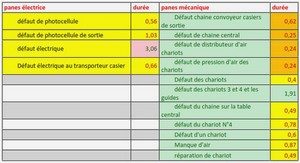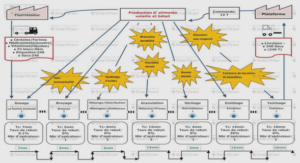Localisation à domaine borné
Le problème (2.10) est donné sur R, afin de discrétiser ce dernier, on ramène le problème (2.10) sur un intervalle ]−l,+l[ où l est une constante bien choisit (voir [26]). Et on est amené à imposé une condition au bord de type de Dirichlet. Cette procédure a été approuvée par P. Jaillet, B. Lapeyre, D. Lamberton (voir [10], [23]). Ce résultat nous permet, au lieu de calculer u solution de (2.6) sur R, il suffit de la calculer sur Ω = ]−l,+l[. Ainsi, nous obtenons un problème d’inéquation parabolique avec une condition au bord de type Dirichlet s’écrit : ∂u ∂t − Au ≥ 0, u ≥ ψ, ∂u ∂t − Au ! (u−ψ) = 0, (3.1) pour t ∈ (0,T] et x ∈ Ω, avec la condition initial u(x,0) = ψ(x), x ∈ Ω, Chapitre 3. Problème discret 30 avec condition au bord Dirichlet : u(t,x) = ψ(x),x ∈ ∂Ω. (3.2) Une intégration par parties nous permet d’écrire, pour u,v ∈ D(Ω) (Au,v) = −a(u,v). Posons a(u,v) = σ 2 2 Z +l −l ∂u ∂x ∂v ∂xdx−β Z +l −l ∂u ∂xvdx+r Z +l −l uvdx. La formulation variationnelle du problème (3.1) peut, alors, être écrite sous forme (voir [29]) : Trouver u ∈ L 2 ([0,T],V ), ∂u ∂t ∈ L 2 ([0,T],H) tel que u ∈ Kψ ∂u ∂t ,v −u ! +a(u,v −u) ≥ 0, pour tout v ∈ Kψ, (3.3) avec la condition initiale u(0,x) = ψ(x), (3.4) et Kψ = {v | v ∈ VΩ, v ≥ ψ sur Ω et u(t,x) = ψ(x), sur ∂Ω}. (3.5) 3.2 Discrétisation du problème par la méthode des éléments finis Pour calculer une solution approchée de (3.3), nous procédons à une discrétisation en temps à l’aide du θ −schema ´ et la discrétisation en espace par élément finis. Chapitre 3. Problème discret
Discrétisation en temps
Subdivisions de l’intervalle [0,T], en N sous intervalle de longueur égale k = T N . Posons ensuite tn = n k, 0 ≤ n ≤ N, et u n = u(tn). Alors u n+1 −u n k ,v −u θ,n+1! +a u θ,n+1,v −u θ,n+1 ≥ 0, pour tout v ∈ Kψ, (3.6) où u θ,n+1 = θun+1 + (1−θ)u n , (3.7) avec u 0 = ψ.
Discrétisation en espace
Considérons la subdivisions de l’intervalle Ω en m+ 1 sous intervalle de même longueur h = 2l m+ 1 . Soit xi = −l + ih, 0 ≤ i ≤ m + 1, et u n h = (u1,…,um) T désigne le vecteur d’approximation de la solution u(t,x) par rapport à l’instant t et la position x. Soit Vh sousespace vectoriel engendré par des fonctions de base à support minimal, c’est-à-dire, elle doivent être non nulles sur un nombre minimal de sous-intervalle. Cette propriété est vérifiée par les fonctions de base suivantes, appelées fonctions chapeaux, voir la figure (3.1) Chapitre 3. Problème discret 32 φi(x) = x−xi−1 h si x ∈ [xi−1,xi ], xi+1 −x h si x ∈ [xi ,xi+1], 0 sinon. , i = 1,··· ,m. (3.8) Les fonctions (3.11) sont telles que φi(xj ) = δij = 1 si i = j, 0 sinon. FIGURE 3.1 – Fonction de base linéaire. Pour tout vh ∈ Vh, on a vh(x) = Xm j=1 vjφh,j (x), (3.9) v 0 h (x) = Xm j=1 vjφ 0 h,j (x), (3.10) Chapitre 3. Problème discret 33 avec φ 0 i (x) = 1 h si x ∈ [xi−1,xi ], −1 h si ∈ [xi ,xi+1], 0 sinon. , i = 1,··· ,m. (3.11) Définissons (uh,vh)h = Z Ω uhvhdx , ∀uh,vh ∈ Vh, et |vh|h = q (vh,vh)h = |vh|L2(Ω) , kvhkh = |vh| 2 L2(Ω) + ∂vh ∂x L2(Ω) 1 2 . Nous savons que |vh|h ≤ kvhkh , ∀vh ∈ Vh. Selon (3.10), alors (voir [30]) kvhkh ≤ C0 h |vh|h , ∀vh ∈ Vh. (3.12) Par ailleurs, on approche Kψ définit en (3.5) par Kh = {vh | vh ∈ Vh, vh ≥ ψh p.p sur Ω et v0 = 0, vm+1 = ψ(−l)}. Chapitre 3. Problème discret 34 Le problème discret est : trouver u ∈ Kh tel que u n+1 h −u n h k ,vh −u θ,n+1 h ! +ah u θ,n+1 h ,vh −u θ,n+1 h ≥ 0, ∀vh ∈ Kh, (3.13) où u θ,n+1 h = θun+1 h + (1−θ)u n h , avec u 0 h = ψ. Nous définissons pour tout uh et vh ∈ Vh ah (uh,vh) = σ 2 2 Z +l −l ∂uh ∂x ∂vh ∂x dx−β Z +l −l ∂uh ∂x vhdx+r Z +l −l uhvhdx, la forme bilinéaire associée à cet opérateur Ah= σ 2 2 ∂ 2 ∂x2 +β ∂ ∂x −r. Il est évident, par une intégration par parties, que : (Ahu,v) = −ah (uh,vh). Chapitre 3. Problème discret 35 3.2.3 Forme matricielle L’inéquation variationnelle parabolique discrète (3.13) est vérifie pour vh = u θ,n+1 h +φi ≥ ψ, ce qui donne u n+1 h −u n h k ,φi ! +ah u θ,n+1 h ,φi ≥ 0, (3.14) ou encore u n+1 h −u n h ,φi +k ah u θ,n+1 h ,φi ≥ 0, (3.15) en utilisant (3.7) et (3.9)-(3.10) Xm j=1 [(φj ,φi) +k θ ah (φj ,φi)] u n+1 j − Xm j=1 [(φj ,φi) +k (1−θ) ah (φj ,φi)] u n j ≥ 0. (3.16) Posons Mij = (φj ,φi), Rij = ah (φj ,φi). la matrices de rigidité R = (Ri,j ) et la matrice masse M = (Mi,j ). Le problème à résoudre, à chaque pas de temps, est donc : trouver u n+1 h ∈ Kh (M+k θR)u n+1 h −(M−k (1−θ)R)u n h ,vh −u n+1 h ≥ 0,∀vh ∈ Kh, (3.17) avec la condition initial u 0 h = ψ. Chapitre 3. Problème discret 36 Construction des matrices M et R Le calcul des coefficients des matrices M et R se fait sur chaque intervalle [xi ,xi+1]. Les éléments diagonaux de la matrice de rigidité R Ri,i = ah (φi ,φi) = σ 2 2 Z xi+1 xi−1 φ 0 i 2 (x)dx−β Z xi+1 xi−1 φ 0 i φi(x)dx+r Z xi+1 xi−1 φ 2 i (x)dx, Ri,i = σ 2 2 Z xi xi−1 φ 0 i 2 (x)dx−β Z xi xi−1 φ 0 i φi(x)dx+r Z xi xi−1 φ 2 i (x)dx | {z } I + σ 2 2 Z xi+1 xi φ 0 i 2 (x)dx−β Z xi+1 xi φ 0 i φi(x)dx+r Z xi+1 xi φ 2 i (x)dx | {z } II . Pour I, nous posons z = x−xi−1 I = σ 2 2 Z h 0 1 h 2 dz −β Z h 0 z h 2 dz +r Z h 0 z 2 h 2 dz = σ 2 2h − β 2 + r h 3 . Pour II, nous posons z = x−xi II = σ 2 2 Z h 0 1 h 2 dz +β Z h 0 z h 2 dz +r Z h 0 z 2 h 2 dz = σ 2 2h + β 2 + r h 3 Ri,i = I +II = σ 2 h + r h 3 . Chapitre 3. Problème discret 37 Les éléments hors diagonaux de la matrice de rigidité R Ri,i+1 = ah (φi+1,φi) = σ 2 2 Z xi+1 xi φ 0 i+1 φ 0 i (x)dx−β Z xi+1 xi φ 0 i+1 φi(x)dx+r Z xi+1 xi φi+1 φi(x)dx. Nous posons z = x−xi , alors Ri,i+1 = σ 2 2 Z h 0 1 h −1 h dz −β Z h 0 1 h h−z h ! dz +r Z h 0 z h h−z h ! dz = − σ 2 2h − β 2 +r h 6 . De même pour Ri−1,i = ah (φi ,φi−1) = σ 2 2 Z xi xi−1 φ 0 i φ 0 i−1 (x)dx−β Z xi xi−1 φ 0 i φi−1 (x)dx+r Z xi xi−1 φi φi−1 (x)dx = − σ 2 2h + β 2 +r h 6.



